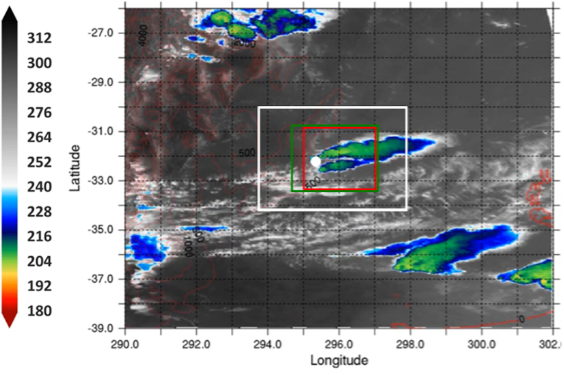Case Description: 22 January 2019
Summary
Two intense systems develop next to each other
Description
Relatively calm background until isolated convective initiation over the site at 19:15 UTC with rapid growth into an intense system. A secondary cell initiates at 20:45 UTC that develops adjacent to the existing system until both systems start to decay by the end of the day. Strong shear is present. CAPE values are in the top third of their ranges (at 20 UTC MUCAPE=3420; MLCAPE=2920 J kg-1).
Available assets
CSAPR2, CSU C-Band data
Unavailable: GOES rapid scan, G1, RELAMPAGO data
Critical period: 19:15–22:15

Figure 7 GOES16 band 13 brightness temperature at 2019-01-22 at 21:45 UTC. Two intense systems develop next to each other.
Available LES ensemble members
Impression |
Ensemble Member |
Cloud Behavior |
|---|---|---|
Poor |
EDA00-Morr |
Model initiates 0.5 h early and immediately grows into a forked pattern by 20:30 UTC versus the cohesive system observed, which is also composed of underdeveloped convection. |
Dud |
GEFS01 |
Initiates late by 1.5 h and underdevelops. |
Poor |
GEFS18 |
Initiates 1 h late and underdevelops. It does get some of the forked pattern by 21:15 UTC. The main issue is the simulated cells are shifted northward. |
Marginal |
GEFS18-Morr |
Initiation timing good and just a tad north. Misses the rapid upscale development from 19:15 to 20:45 UTC, being seriously underdeveloped at 20:15. Model development catches up to observed by 21:30, showing the development of a second cell forming a forked pattern with a slight northward displacement. At 22:30, shows the 3-forked pattern, albeit slightly displaced eastward and with an errant cell just south of the AMF. After that, the simulated systems start moving east while the observed systems mostly stay put. |